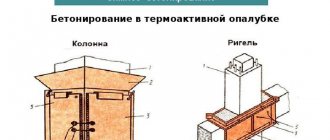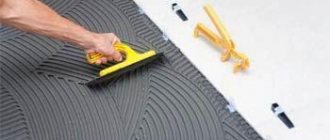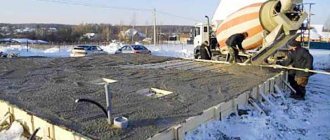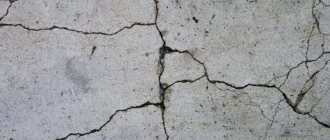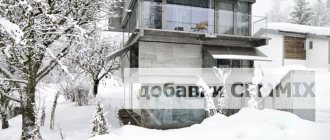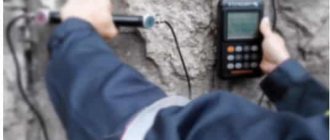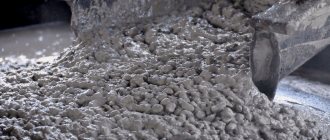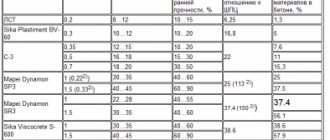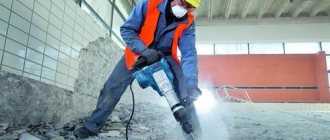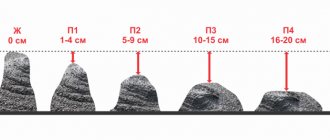Tips for builders | 07/12/2016
Construction in modern conditions does not stop even in the cold season: in winter, this process becomes more complicated due to weather conditions and begins to require the use of certain technologies. For example, for concrete to set properly, it must be heated, but how can this be done in winter?
There are many methods for heating concrete in winter. These are quite complex and expensive methods, however, if you ignore them, the concrete will not gain strength and will not meet the design requirements. To heat concrete, PNSV wires are most often used. To start the process, you will need a transformer or welding machine. The second option is weaker and will not give a quick and high-quality effect like the first.
Thermal mats for heating concrete
The thermomat for heating concrete is not some new invention: it has been actively used for more than ten years at all construction sites in the country. The method is especially popular in northern regions, where the need to warm up structures is more acute. The method has proven itself well, but has been improved over the years.
Thermoelectromats are devices that can operate autonomously. The warm-up time is set automatically, and a person does not need to monitor turning the equipment on and off. The devices consume significantly less electricity than what happens when the structure is heated using wires. The method allows you to heat the material efficiently. Heating occurs evenly, local overheating does not occur: this means that the concrete will harden without microcracks and will have high strength.
Advantages of this method:
- Easy to use;
- The equipment does not require complex maintenance;
- There is no need to control the heating temperature, control is carried out automatically;
- High quality heating;
- In 12 hours the mixture reaches 70% brand strength.
Flaws:
- Thermomats are expensive, and not every developer can purchase them;
- Most of the products on the market are fakes that are not suitable for heating concrete, since they consist of a Korean heating film designed for use as a heated floor. The power of such devices is too low to heat the concrete mixture.
It is quite possible to distinguish a fake: you need to pay attention to how the film is applied. In devices for heated floors, it is applied in stripes; in devices for heating concrete, a layer of film is applied evenly.
What kind of "beast"
A greenhouse is a temporary structure erected around a construction site to maintain above-zero temperatures inside.
This could be like a tent stretched over the foundation after pouring. And sometimes there is a huge tent around the perimeter of the entire facility, if we are talking about insulation or finishing the facade. Film is used as an insulating material - regular, reinforced, heat-shrinkable, as well as tarpaulin or PVC awnings. Wooden beams are used for the frame; supports are knocked together from them, onto which the insulator is stretched. To minimize heat loss, the film is soldered into a single sheet using irons or burners.
Inside the greenhouse, the temperature is maintained by heat guns running on electricity, diesel fuel or gas, depending on the communications available at the site.
Warming up concrete in winter using PNSV wire
This is a fairly simple way to warm up. It is used in 70% of cases, as it is very affordable. In order to make this possible, it is necessary to take care of the installation of the wires in advance, so first lay the PNSV wire, and then pour the concrete mixture. The cable is heated using a transformer, which creates a reduced voltage.
Advantages:
- Low cost of the procedure. A transformer consumes significantly less energy than other equipment, so it is very relevant if the budget is limited. It is also not necessary to buy it: it is quite possible to rent the necessary equipment for a while.
- An 80 kW step-down transformer is suitable for heating the concrete mixture. Using such equipment, 90 m3 of concrete can be heated without problems.
- It is possible to lay the wire in any weather.
The method is not without its drawbacks:
- It is necessary to take care of the heating procedure in advance, lay the wire, lay heating loops (the wire is laid using a special technology: it is not enough to simply concrete it, it is necessary that the structure covers all the concrete, for which it is laid with loops that are secured in a special way, similar to laying heated floors) .
- The method requires physical effort from workers.
Warming up concrete in winter with electrodes
It is not necessary to use PNSV wire for heating: reinforcement tied with 8-10 mm wire rod is suitable for this purpose. This method is not suitable if it is necessary to pour a slab foundation or concrete slab. It is usually used when pouring columns, diaphragms, and walls: this heating method is quite convenient and does not require extra costs.
A transformer is also required for operation. Metal rods are connected to it, which are connected to the concrete structure. The step-down transformer will supply a reduced voltage, which will heat up the metal parts of the structure.
Ambient temperature is an important factor to consider when determining the electrode spacing. The standard interval is 0.6-1 meter. Heating of concrete is carried out due to the moisture contained in its mass. The transformer supplies three phases to the structure. The areas located between the installed electrodes warm up. If it is necessary to warm up the column, then it will be enough to install one electrode, since heating of the concrete in winter will occur due to the contact of the structure with the transformer phase and the ground.
Advantages of this method:
- Fast, uncomplicated installation of heating;
- Inexpensive materials used for installation.
The disadvantages include the following:
- High energy consumption by electrodes. One electrode requires approximately 45-50 amperes
- An 80 kW step-down transformer cannot be connected to a large number of electrodes. Its power may not be enough. To solve the problem, it is recommended to use several transformers.
- The reinforcement and wire cannot be removed from the structure after warming up; it will remain there forever.
You can build a concrete foundation in winter in construction greenhouses produced by the Izaprom company! Each product has an assembly passport, which allows the greenhouse to be used at different construction sites. The production of greenhouses includes a collapsible metal frame and an awning covering.
We manufacture prefabricated buildings, hangars and prefabricated structures.
Temporary structure - greenhouse, construction shelters, shelter for drilling rigs, shelter for concrete, tent canopies.
Warehouses are temporary structures and are divided into volumetric and flat. Warmhouses can be frame-tent, collapsible or simply tent-type.
A volumetric greenhouse is a structure within which concrete structures are placed and installed before pouring begins, and concrete work is carried out directly in the greenhouse.
A volumetric greenhouse is a structure within which concrete structures are placed and installed before pouring begins, and concrete work is carried out directly in the greenhouse. Volumetric greenhouses are manufactured and installed for concreting tunnels, pipelines, foundations, retaining walls and other structures. To reduce costs they are made mobile. Hothouses are heated with heat guns, portable stoves, air heaters, or with the help of tubular registers through which hot water or steam circulates. The duration of heating is set depending on the type of cement and the required strength of concrete. A flat greenhouse is a removable steam jacket or box. Concreting of the structure is carried out outdoors; the laid concrete is covered with removable boxes equipped inside with heating devices, after turning on which the necessary heat and humidity environment is created in the greenhouses. Flat greenhouses are quite economical and have small sizes. Used for concreting small foundations, slabs, bridge columns, beams, etc.
The cost of greenhouses is (with the height of the walls of the greenhouse up to 2 m) - from 3500 to 4000 rubles per 1 m2 (with an area of 100 m2).
As the area covered by the greenhouse increases, the cost per square meter decreases. The exact price is determined when calculating the design.
The estimate for the installation of greenhouses with a metal frame is calculated as the construction of temporary buildings and structures in the winter. It’s easy to order a greenhouse at the manufacturer’s price, use any convenient method of communication. Our company works with any budget throughout Russia.
Advantages of greenhouses (construction shelters)
Frame-tent shelter for concreting with the ability to carry sections manually or on wheeled supports.
Formwork for heating concrete
For this method, formwork is used, into the panels of which a heating element is inserted. The convenience of the design lies in the fact that, if necessary, you can easily replace its faulty elements. If the house is monolithic, then with the help of such formwork you can warm it up completely. If you warm up the floors in stages, then the formwork can be rearranged, moving on to the desired area of work. This method can be used even at an ambient temperature of -25 degrees.
The advantages of this technique:
- High performance with relatively low energy consumption;
- Requires little time for preparation and installation;
- Can be used in severe frosts;
- Can be used several times.
Flaws:
- High price.
- It is inconvenient if the structure is non-standard.
Question 2. Concreting in greenhouses. Concreting with
Concreting in greenhouses.
Hothouses are temporary enclosing structures and can be three-dimensional, covering the entire concrete structure, flat or sectional.
The temperature in the greenhouse is maintained within 5.10°C, due to which the hardening of concrete slows down, and the time it takes for concrete to acquire stripping strength increases.
Concreting structures in greenhouses is rarely used, since this work is very labor-intensive and a lot of material is required to construct greenhouses.
Concrete with antifreeze additives.
The method is based on the property of concrete, mixed with aqueous solutions of a number of chemicals, to harden at subzero temperatures.
Calcium chloride CaCI2 (CC) and sodium chloride NaCI (XH), potassium carbonate (potash) K2CO3 (P), sodium nitrite NaNO2 (HH) are used as the main antifreeze additives. A number of complex compounds are also used experimentally.
Anti-frost additives have different effects on the properties of concrete mixtures and concrete.
The amount of additives introduced into concrete mixtures is determined by the type of additive and the ambient temperature. The maximum amount of additives is 15% by weight of cement.
Concrete
with antifreeze additives
in structures subject to dynamic loads; in prestressed structures; in parts of structures located in an area of variable water level; in reinforced concrete structures located closer than 100 m from high voltage current sources; during the construction of monolithic chimneys and ventilation pipes, etc.
Concrete with antifreeze additives is laid and compacted in the same way as conventional concrete.
The thermos method.
The “thermos” method involves placing a concrete mixture at a positive temperature (usually 15.30°C) into insulated formwork. As a result, the concrete of the structure gains a given strength due to the initial heat content and exothermic heat release of the cement during cooling to 0 °C.
Read also: Rated current of the circuit breaker
The amount of exothermic heat generated depends on the type of binder used and the holding temperature.
The more massive the concrete structure is, the more effective the method is.
Hothouses are temporary structures, inside of which a positive temperature is maintained and either the entire cycle of concrete work is carried out, or only concrete curing is carried out.
The essence of the method is to create conditions close to summer conditions in the local area around the concrete structure.
The temperature in the greenhouses at the bottom of the concrete structure must be at least 5°C. The average altitude temperature is usually taken to be within 15-25°C.
Hotbeds are used for winter concreting of zero-cycle structures, some structures above the zero level, hydraulic blocks, reinforced concrete household pipes, silos, cooling towers, etc.
Based on the design, dimensions and methods of laying the concrete mixture in them, the following types of greenhouses are used:
– small greenhouses
(installed after laying the concrete mixture): frame structure caps, canvas tents, shelters made of polymer film;
– volumetric
(frame structure or air-supported shells), inside of which the means of mechanized laying of the mixture are located and the entry of vehicles is ensured;
– mobile
(frame structure with a tarpaulin covering), moved along guides along concreted extended structures (usually a zero cycle): the entire cycle of concrete work is carried out inside;
– lifting
, used for the construction of high-rise reinforced concrete structures (chimneys, silos), are awning shelters for work areas that can be moved together with sliding formwork.
To maintain the required temperature in greenhouses, it is recommended to use electric heaters of various designs or air heaters running on liquid fuel.
Calculation of greenhouses
The initial data for the calculation are:
– overall dimensions of the structure;
– geometric dimensions of the greenhouse, heat transfer coefficient of the fence K ;
– required concrete strength R tr
;
– initial temperature of concrete tb.n
;
– outside air temperature tn.v
and wind speed.
The calculation comes down to determining the power of the heaters and the duration of the heat treatment.
1. The power required to compensate for heat loss through the fencing of the greenhouse and into the ground is determined by the formula:
, kW (2.30)
where m is a coefficient taking into account the leakage of the fence ( m
= 1.1 for small greenhouses;
m
= 1.2 for other greenhouses);
F i
and
K i
are, respectively, the area (m 2 ) and heat transfer coefficient (W/m 2 °C)
the i
-th section of the greenhouse fencing;
F Г – soil area inside the greenhouse, m2; KG – soil heat transfer coefficient (recommended to be equal to 0.5 W/m 2 °C).
The heat transfer coefficients of the fence are taken according to Appendix 3 or calculated using formula 1.2.
2. The duration of curing of concrete until the required strength is achieved is determined according to the strength growth graphs (Appendix 11) depending on the average temperature.
Date added: 2016-04-06; ; ORDER A WORK WRITING
Reliable methods of heating when curing concrete are steam heating and air heating (in greenhouses or tents). For heating monolithic structures, these methods are used only under the condition of a feasibility study and the impossibility of electrical heating of concrete.
Steam heating of concrete.
Steam heating involves creating favorable heat and humidity conditions using steam, which significantly accelerates the hardening of concrete. Like electric heating, it consists of the stages of heating to a given temperature, isothermal heating at this temperature and cooling.
During steam heating, the temperature in concrete increases with the same intensity as during electric heating. The maximum heating temperature of concrete when using quick-hardening cements should not exceed 70, for Portland cement - 80, and for slag Portland cement and pozzolanic Portland cement - 90 ° C.
When heating monolithic structures, due to large heat losses, the heating temperature of concrete usually does not exceed 70° C. At this temperature, in 24–28 hours you can obtain the same strength as in 10–15 days when concrete hardens in air at a temperature of 15° WITH.
Read also: PML 2160m connection diagram
The duration of isothermal heating depends on the type of cement used, the heating temperature and the specified strength of the concrete. It can be determined approximately using special strength graphs with clarification based on the results of testing control cubes for compression. The concrete is heated with saturated low pressure steam. To do this, high-pressure steam is first passed through a reducer, which reduces the steam pressure.
The cooling rate of concrete should not exceed the values specified for electrical heating.
The most common method is steam heating of concrete using a steam jacket. With this method, a full or partial shell (jacket) is installed, covering the heated structure or its element together with the formwork and ensuring free steam flow around the surface of the concrete (or formwork).
Steam jackets are installed before concreting. The enclosures of steam jackets must be dense, have low thermal conductivity and be no more than 15 cm away from the formwork or concrete, forming a space for steam inlet. Usually they are made from insulated wooden panels 2 or plywood with a roofing felt layer 5. The panels are tightly fitted to one another, and the seams between them are covered with strips or coated with clay.
| Scheme of a steam jacket for heating reinforced concrete ribbed floors |
| 1 - flexible hose, 2 - insulated panels, 3 - linings, 4 - flooring made of boards, 5 - roofing felt, 6 - sawdust, 7 - temperature wells, 8 - holes for steam passage, 9 - concrete |
When steam heating ribbed ceilings, steam jackets are installed at the bottom and top. The upper steam jacket is installed only after concrete has been laid in the ceiling. Steam for heating the ceiling is released through pipes or flexible hoses 1 into the lower steam jacket. Typically, one entry is made for every 5-8 m2 of floor surface. To allow steam to pass into the upper steam jacket, special holes 8 measuring 10x10 cm are left in the slab when laying concrete.
The steam jacket for columns, beams, purlins, crossbars and arches is assembled from inventory insulated panels. Steam is admitted every 2-3 m along the length of the beam or purlin and every 3-4 m along the height of the column into separate compartments of the steam jacket.
When heating partitions and walls, a steam jacket is installed only on one side, opposite to the concreting. On the other hand, as the concrete mixture is laid, the formwork is expanded and insulated. With such one-sided heating, due to the small thickness of the structure, the temperature of the concrete on the surface under the insulated formwork will be only slightly lower than on the surface facing the steam jacket.
To distribute steam evenly in the jacket, it is introduced through a steam distribution box.
Vertically located elements are heated in the so-called capillary formwork, which is a modified conventional formwork made of boards 38 mm thick. The advantage of capillary formwork compared to a steam jacket is that it requires less timber and thermal insulation.
In capillary formwork, steam passes through narrow triangular or rectangular vertical channels (capillaries) 1, which are made in the formwork panels 3 on the side facing the concrete. To form channels, cut off the edges of the formwork boards or select quarters in the boards and then cover the resulting grooves with strips of 2 roofing steel.
| Capillary formwork for steam heating of columns |
| 1 - channels for steam, 2 - strips of roofing steel, 3 - formwork panel, 4 - clamp, 5 - concrete |
Steam from the steam line enters steam distribution boxes, usually located at the bottom of columns or walls, and from there, through holes drilled in the formwork, into capillaries through which it moves in the vertical direction. The upper ends of the capillaries are closed with wooden plugs to prevent concrete from getting into them, and the steam escapes through holes drilled in the upper part of the capillaries. When the height of the columns is more than 3.5 m, additional steam injection is arranged in the middle of the columns.
Read also: Stretch bars with lanyards for deflectors
To preheat the formwork, steam is released 20-30 minutes before concreting begins. To release condensate, holes are provided in the steam distribution boxes, closed with plugs.
Air heating of concrete.
Air heating of concrete structures is based on the creation of favorable heat and humidity conditions in a confined space as a result of intensive evaporation of excess water from concrete at elevated temperatures.
An enclosed space is created with special fences: a greenhouse or a tent, inside of which heating devices are placed. Tents, unlike greenhouses, are moved upward as concrete structures grow. The greenhouses are dismantled after the structure has been cured and reassembled in a new location.
When curing concrete in greenhouses or tents at a level of 0.5 m from the bottom of the fence, the temperature must be maintained at least 5° C.
The greenhouses cover the entire structure and create a space within which concrete is poured. In order to save heat, the dimensions of the greenhouse are taken to be minimal. The roof 1 of insulated panels is placed 2 m above the concrete structure, and the side fences 2 are placed at a distance of 0.5 m from the formwork of the structure.
| Hothouse for the construction of reinforced concrete walls |
| 1 — roof made of insulated panels, 2 — side railings made of insulated panels, 3 — steam heating pipes, 4 — trolley |
Hothouses are usually used for concreting foundations and other massive structures. The walls of the trenches are used as side fences.
Hothouses are heated by portable stoves or heaters, and sometimes by pipes through which steam is passed.
Hothouses for curing concrete are expensive, so they are used only in exceptional cases when the thermos method cannot be used.
In some cases, when using a greenhouse once, it is rational to use lightweight canvas or plywood greenhouses, which require increased heating costs, but their designs are cheaper than those made from insulated panels. It is also allowed to use greenhouses when concreting reinforced concrete floors resting on lined walls. The laid concrete is heated from below and from above. To heat the concrete, a flooring of panels or a tarpaulin shelter is installed on top, which are 15-20 cm from the concrete. Warm air is supplied into this space from below through holes in the ceilings. The enclosures of the heated space should not allow moisture evaporating from the concrete to pass through. If the air humidity is insufficient, then the structure is sprayed with water, or vessels with water are brought into the greenhouse.
Tents are used in hydraulic engineering when concreting massive blocks. They cover the block being concreted from above and from the sides and create a space within which the concrete is poured.
The tent is a rigid spatial structure made of steel longitudinal and transverse trusses with consoles hanging from the sides. The consoles carry the lateral insulation of the tent and absorb the lateral pressure of the concrete on the formwork. The tent supports are 3 columns made of prefabricated reinforced concrete or metal. Jacks are installed on each column to lift the tent to the next position.
| Movable tent |
| 1 — gantry crane with a lifting capacity of 1.5 tons, 2 — vibration package IV-12, 3 — supporting reinforced concrete columns, 4 — adjustable formwork |
The roof of the tent is made flat with a system of hatches that are tightly closed with lids. Through the hatches, concrete mixture is supplied in buckets and the IV-12 vibrating package, supported by gantry crane 1, is lowered. The required positive temperature in the tent is maintained by electric heaters.
Movable tents are expensive, but in harsh climates and large volumes of work they are economically justified.
Add a comment Cancel reply
You must be logged in to post a comment.
Induction heating of concrete in winter
This heating method is used quite rarely and accounts for less than ten percent. Heating of the material is carried out due to magnetic induction, converted into heat. This process is possible through the use of turns of insulated wire and metal parts built into the structure.
The main difficulty of the process is that it is necessary to accurately calculate the turns of the wire, taking into account the amount of metal in the structure. Often this is almost impossible to do, which is why the magnetic induction method is unpopular.
Infrared heating of concrete
Targeted infrared units can make it much easier to warm up concrete in the winter. The installation does not need to be mounted anywhere: heating can occur directly through the formwork of the structure. An infrared installation allows you to efficiently heat open concrete surfaces. It is suitable for working with any structure, regardless of its shape. Heat adjustment is quite simple: it is carried out by moving the heating element away or closer to the structure.
Advantages:
- The method effectively consumes electricity and efficiently heats the concrete.
Flaws:
- High price of equipment. If the production volume is large, then a lot of infrared installations are required, which is unprofitable for the developer.
- The method removes moisture from the concrete, which can weaken its strength. To avoid this problem, it is recommended to cover the structure with film.
Laying concrete in winter
To avoid premature cooling when pouring the monolith, the concrete pump hoses are wrapped in slag wool, felt, or burlap. At temperatures below -10°C, the trunk is placed in insulated boxes and heated with steam.
If concrete is supplied using a vibrating chute or conveyor, wind protection from shields is installed around it and covered with a tarpaulin.
Currently reading: Concrete columns
To speed up the hardening time, fresh concrete is vibrated. This allows the use of more rigid mixtures with a lower water-cement ratio. During processing, the density of the solution increases due to the release of air bubbles. After laying, the surface is covered with tarpaulin and matting.
